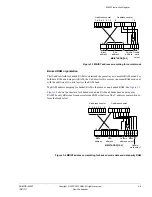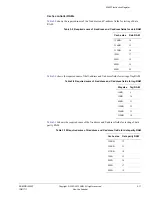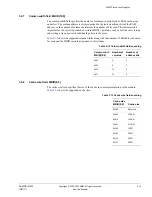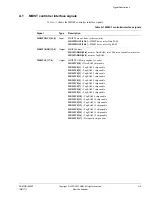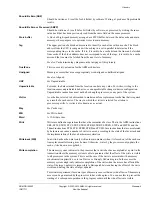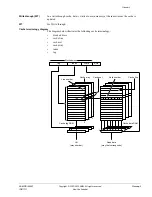
Glossary
ARM DDI 0402F
Copyright © 2007-2010 ARM. All rights reserved.
Glossary-4
ID011711
Non-Confidential
Should Be Zero (SBZ)
Should be written as 0 (or all 0s for bit fields) by software. Writing a 1 produces Unpredictable
results.
Should Be Zero or Preserved (SBZP)
Should be written as 0 (or all 0s for bit fields) by software, or preserved by writing the same
value back that has been previously read from the same field on the same processor.
Store buffer
A block of high-speed memory, arranged as a FIFO buffer, between the data cache and main
memory, whose purpose is to optimize stores to main memory.
Tag
The upper portion of a block address used to identify a cache line within a cache. The block
address from the CPU is compared with each tag in a set in parallel to determine if the
corresponding line is in the cache. If it is, it is said to be a cache hit and the line can be fetched
from cache. If the block address does not correspond to any of the tags, it is said to be a cache
miss and the line must be fetched from the next level of memory.
See also
Cache terminology diagram on the last page of this glossary.
TrustZone
This is a security extension for the ARM architecture.
Unaligned
Memory accesses that are not appropriately word-aligned or halfword-aligned.
See also
Aligned.
UNP
See
Unpredictable.
Unpredictable
For reads, the data returned from the location can have any value. For writes, writing to the
location causes unpredictable behavior, or an unpredictable change in device configuration.
Unpredictable instructions must not halt or hang the processor, or any part of the system.
Victim
A cache line, selected to be discarded to make room for a replacement cache line that is required
as a result of a cache miss. The way in which the victim is selected for eviction is
processor-specific. A victim is also known as a cast out.
Way
See
Cache way.
WB
See
Write-back.
Word
A 32-bit data item.
Write
Writes are defined as operations that have the semantics of a store. That is, the ARM instructions
SRS, STM, STRD, STC, STRT, STRH, STRB, STRBT, STREX, SWP, and SWPB, and the
Thumb instructions STM, STR, STRH, STRB, and PUSH. Java instructions that are accelerated
by hardware can cause a number of writes to occur, according to the state of the Java stack and
the implementation of the Java hardware acceleration.
Write-back (WB)
In a write-back cache, data is only written to main memory when it is forced out of the cache on
line replacement following a cache miss. Otherwise, writes by the processor only update the
cache. (Also known as copyback).
Write completion
The memory system indicates to the processor that a write has been completed at a point in the
transaction where the memory system is able to guarantee that the effect of the write is visible
to all processors in the system. This is not the case if the write is associated with a memory
synchronization primitive, or is to a Device or Strongly Ordered region. In these cases the
memory system might only indicate completion of the write when the access has affected the
state of the target, unless it is impossible to distinguish between having the effect of the write
visible and having the state of target updated.
This stricter requirement for some types of memory ensures that any side-effects of the memory
access can be guaranteed by the processor to have taken place. You can use this to prevent the
starting of a subsequent operation in the program order until the side-effects are visible.

